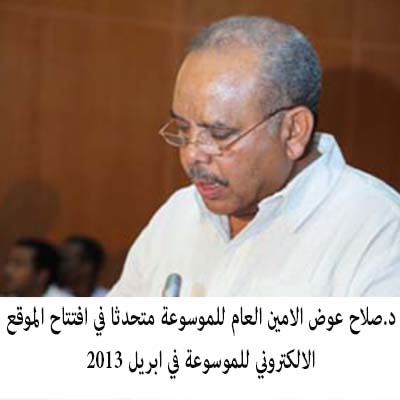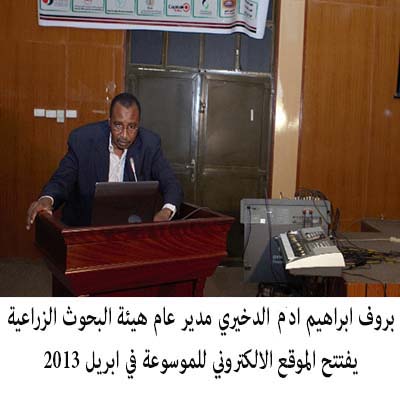إنتاج الالبان
An Assessment of Kuku Dairy Cooperative Production System
كتب بواسطة: Administrator
An Assessment of Kuku Dairy Cooperative Production System
By: Samah Khalafalah Mohamed Omer, B.Sc. Animal Production honors , University of Khartoum , August, 2005
Supervisor: Dr. Lutfi Mohamed-Ahmed Musa
A dissertation submitted to the University of Khartoum in partial fulfillment for the requirement of the degree of Master of Science in Tropical Animal Production (Genetics and Animal Breeding), Faculty of Animal Productio, University of Khartoum , January, 2010
Abstract
This study aimed at assessing the current situation of Kuku Dairy Cooperative, looking for possible opportunities to promote the cooperative with a view to the development of a community-based improvement breeding programme. A set of detailed structured questionnaires were used to collect information from 56 cooperative’s members in one-visit-interviews. The majority of the members (80%) indicated both fodder cultivation and livestock to be their main activity. The Members were keeping different species of animals, but cattle were the dominant and most important one. Almost all cattle were crossbreds (Kenana or Butana with Friesian) with different levels of foreign blood. Seventy Three percent of the members were educated and were aware of the importance of the collective action in reducing the production costs and enhancing the production condition. Getting services was the main purpose for joining Kuku Dairy Cooperative; however, the members considered ownership of agricultural land (31.7%), milk marketing (21.1%), agricultural inputs (21.1%) and veterinary services (16.3%) to be the primary reasons for joining the cooperative. But, the Cooperative’s activities and services were influenced by inadequacy of funds provided by the central government, especially, during the last few decades which witnessed the liberalization of the Sudanese economy and suspension of foreign technical and financial aid by traditional donors. Nearly half of the members (48%) did not participate in electing the executive committee’s members, because they were not satisfied with the system and because they thought that the committee was monopolized by a group of old members who were elected on grounds of their status in the community and not on the basis of their dairy farming skills or commercial insight. The individual farm herd size was quite small (113 ± 53), and not conducive to achievement of measurable genetic gain which requires the formation of group breeding schemes, which in turn will require the full participation and long- term commitment of the members. A virtual nucleus to recruit the necessary number of bulls for the cooperative’s cattle population may be an option. In particular; this option will integrate farmers’ resources, reduce overhead costs and encourage more farmer participation. Though almost all the members cultivate fodders, the majority stressed the feed expenses in addition to irrigation fees, market and health care expenses to be the most important limiting factors for dairying. Measures designed to overcome these production constraints can only be implemented if the Kuku Dairy Cooperative becomes functional. Through a functional Kuku Dairy Cooperative together with government support, the members can create their own linkage system, infrastructure of marketing and production support services (e.g. animal breeding, health care, feed, other inputs and credit facilities).
المستخلص:
هدفت هذه الدراسة إلى تقييم الوضع الحالي في تعاونية ألبان كوكو و البحث عن إمكانيات تحسين عمل التعاونية وذلك لخدمة أهداف التحسين الوراثي التعاوني. أستخدمت مجموعة من الإستبيانات التفصيلية لجمع البيانات من 56 عضو تعاونية في مقابلات خلال زيارة واحدة. أشار أغلبية الأعضاء (80%) إلى أن تربية الحيوانات الزراعية و إنتاج الأعلاف يشكلان نشاطاً رئيسياً لهم. كان الأعضاء يربون أنواعاً مختلفة من الحيوانات لكن الأبقار كانت هي الأكثر شيوعاً و الأكثر أهمية. كل الأبقار كانت هجينة (كنانة أو بطانة مع فريزيان) بمستويات مختلفة من الدم الأجنبي. شكل المتعلمون 73% من العينة وكانوا مدركين لأهمية العمل الجماعي في تخفيض تكلفة الإنتاج ورفع مستوى الأوضاع الإنتاجية. كان الحصول على الخدمات هو السبب الأهم لإنضمام الأعضاء إلى جمعية ألبان كوكو غير أن الأعضاء إعتبروا إمتلاك الأرض الزراعية (31.7%) وتسويق اللبن (21.1%) و المدخلات الزراعية (21.1%) و الخدمات البيطرية (16.3%) هي الأسباب الرئيسية لإنضمامهم إلى الجمعية. تأثرت أنشطة التعاونية وخدماتها بمحدودية التمويل الذي توفره الحكومة المركزية خاصة خلال العقود الأخيرة والتي شهدت مرحلة تحرير الإقتصاد السوداني وتوقف المعونات الفنية والإقتصادية الأجنبية من المانحين التقليديين. لم يشارك نصف الأعضاء تقريباً (48%) في إنتخاب أعضاء اللجنة التنفيذية لأنهم لم يكونوا مقتنعين بالنظام القائم ولأنهم كانوا يعتقدون أن اللجنة محتكرة بواسطة بعض كبار الأعضاء الذين يتم إنتخابهم على أساس وضعهم في المجتمع وليس على أساس مهاراتهم كمزارعي ألبان أو قدراتهم التجارية. كان حجم القطيع في الحيازة الزراعية الواحدة صغيرا (113± 53)، وبالتالي فإن تحقيق تحسين وراثي ملموس يتطلب تكوين مشروعات تربية جماعية وهذه بدورها تتطلب المشاركة الكاملة و الإلتزام طويل الأمد من الأعضاء. قد يكون أحد البدائل هو تكوين قطيع نواة إفتراضية لإنتخاب العدد الكافي من الثيران للإستخدام في أبقار التعاونية. ستؤدي هذه الطريقة على وجه الخصوص إلى تحقيق تكامل بين موارد المزارعين وإلى تخفيض التكاليف الثابتة وإلى تشجيع المزارعين لمزيد من المشاركة. رغم أن معظم الاعضاء يزرعون أعلافهم إلا أن أغلبيتهم أكدت على أن تكلفة الغذاء بالإضافة إلى رسوم الري وتكاليف التسويق والرعاية الصحية هي أهم العوامل المحددة لإنتاج الألبان. من غير الممكن تطبيق أي إجراءات للتغلب على محددات الإنتاج بدون تفعيل تعاونية ألبان كوكو إبتداءً. من خلال تفعيل هذه التعاونية ودعم الحكومة يمكن لأعضاء الجمعية خلق روابط بينهم وُبنى تحتية لخدمات التسويق و الإنتاج ( على سبيل المثال: خدمات تحسين الحيوان، الرعاية الصحية، التغذية، وغيرها من المدخلات وخدمات التمويل).
Abstract
This study aimed at assessing the current situation of Kuku Dairy Cooperative, looking for possible opportunities to promote the cooperative with a view to the development of a community-based improvement breeding programme. A set of detailed structured questionnaires were used to collect information from 56 cooperative’s members in one-visit-interviews. The majority of the members (80%) indicated both fodder cultivation and livestock to be their main activity. The Members were keeping different species of animals, but cattle were the dominant and most important one. Almost all cattle were crossbreds (Kenana or Butana with Friesian) with different levels of foreign blood. Seventy Three percent of the members were educated and were aware of the importance of the collective action in reducing the production costs and enhancing the production condition. Getting services was the main purpose for joining Kuku Dairy Cooperative; however, the members considered ownership of agricultural land (31.7%), milk marketing (21.1%), agricultural inputs (21.1%) and veterinary services (16.3%) to be the primary reasons for joining the cooperative. But, the Cooperative’s activities and services were influenced by inadequacy of funds provided by the central government, especially, during the last few decades which witnessed the liberalization of the Sudanese economy and suspension of foreign technical and financial aid by traditional donors. Nearly half of the members (48%) did not participate in electing the executive committee’s members, because they were not satisfied with the system and because they thought that the committee was monopolized by a group of old members who were elected on grounds of their status in the community and not on the basis of their dairy farming skills or commercial insight. The individual farm herd size was quite small (113 ± 53), and not conducive to achievement of measurable genetic gain which requires the formation of group breeding schemes, which in turn will require the full participation and long- term commitment of the members. A virtual nucleus to recruit the necessary number of bulls for the cooperative’s cattle population may be an option. In particular; this option will integrate farmers’ resources, reduce overhead costs and encourage more farmer participation. Though almost all the members cultivate fodders, the majority stressed the feed expenses in addition to irrigation fees, market and health care expenses to be the most important limiting factors for dairying. Measures designed to overcome these production constraints can only be implemented if the Kuku Dairy Cooperative becomes functional. Through a functional Kuku Dairy Cooperative together with government support, the members can create their own linkage system, infrastructure of marketing and production support services (e.g. animal breeding, health care, feed, other inputs and credit facilities).
المستخلص:
هدفت هذه الدراسة إلى تقييم الوضع الحالي في تعاونية ألبان كوكو و البحث عن إمكانيات تحسين عمل التعاونية وذلك لخدمة أهداف التحسين الوراثي التعاوني. أستخدمت مجموعة من الإستبيانات التفصيلية لجمع البيانات من 56 عضو تعاونية في مقابلات خلال زيارة واحدة. أشار أغلبية الأعضاء (80%) إلى أن تربية الحيوانات الزراعية و إنتاج الأعلاف يشكلان نشاطاً رئيسياً لهم. كان الأعضاء يربون أنواعاً مختلفة من الحيوانات لكن الأبقار كانت هي الأكثر شيوعاً و الأكثر أهمية. كل الأبقار كانت هجينة (كنانة أو بطانة مع فريزيان) بمستويات مختلفة من الدم الأجنبي. شكل المتعلمون 73% من العينة وكانوا مدركين لأهمية العمل الجماعي في تخفيض تكلفة الإنتاج ورفع مستوى الأوضاع الإنتاجية. كان الحصول على الخدمات هو السبب الأهم لإنضمام الأعضاء إلى جمعية ألبان كوكو غير أن الأعضاء إعتبروا إمتلاك الأرض الزراعية (31.7%) وتسويق اللبن (21.1%) و المدخلات الزراعية (21.1%) و الخدمات البيطرية (16.3%) هي الأسباب الرئيسية لإنضمامهم إلى الجمعية. تأثرت أنشطة التعاونية وخدماتها بمحدودية التمويل الذي توفره الحكومة المركزية خاصة خلال العقود الأخيرة والتي شهدت مرحلة تحرير الإقتصاد السوداني وتوقف المعونات الفنية والإقتصادية الأجنبية من المانحين التقليديين. لم يشارك نصف الأعضاء تقريباً (48%) في إنتخاب أعضاء اللجنة التنفيذية لأنهم لم يكونوا مقتنعين بالنظام القائم ولأنهم كانوا يعتقدون أن اللجنة محتكرة بواسطة بعض كبار الأعضاء الذين يتم إنتخابهم على أساس وضعهم في المجتمع وليس على أساس مهاراتهم كمزارعي ألبان أو قدراتهم التجارية. كان حجم القطيع في الحيازة الزراعية الواحدة صغيرا (113± 53)، وبالتالي فإن تحقيق تحسين وراثي ملموس يتطلب تكوين مشروعات تربية جماعية وهذه بدورها تتطلب المشاركة الكاملة و الإلتزام طويل الأمد من الأعضاء. قد يكون أحد البدائل هو تكوين قطيع نواة إفتراضية لإنتخاب العدد الكافي من الثيران للإستخدام في أبقار التعاونية. ستؤدي هذه الطريقة على وجه الخصوص إلى تحقيق تكامل بين موارد المزارعين وإلى تخفيض التكاليف الثابتة وإلى تشجيع المزارعين لمزيد من المشاركة. رغم أن معظم الاعضاء يزرعون أعلافهم إلا أن أغلبيتهم أكدت على أن تكلفة الغذاء بالإضافة إلى رسوم الري وتكاليف التسويق والرعاية الصحية هي أهم العوامل المحددة لإنتاج الألبان. من غير الممكن تطبيق أي إجراءات للتغلب على محددات الإنتاج بدون تفعيل تعاونية ألبان كوكو إبتداءً. من خلال تفعيل هذه التعاونية ودعم الحكومة يمكن لأعضاء الجمعية خلق روابط بينهم وُبنى تحتية لخدمات التسويق و الإنتاج ( على سبيل المثال: خدمات تحسين الحيوان، الرعاية الصحية، التغذية، وغيرها من المدخلات وخدمات التمويل).


